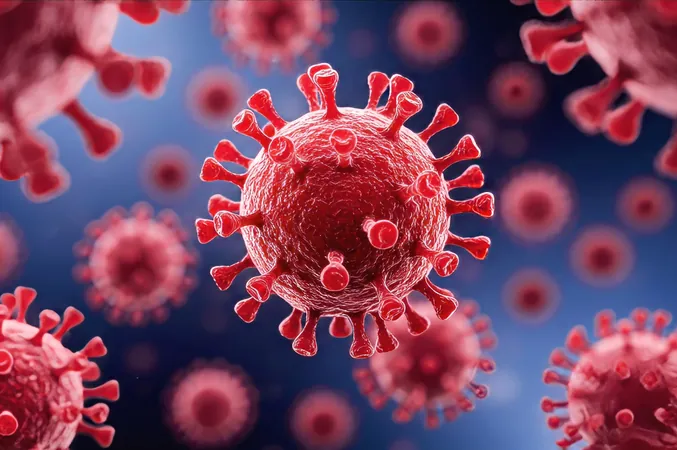
Unveiling the True Journey of COVID: Not Just Bats!
2025-05-09
Author: Yu
The Unlikely Journey of COVID-19's Ancestor
Viruses don’t need wings to spread; they simply need a ride. New research reveals that the ancestor of SARS-CoV-2, the virus responsible for the COVID-19 pandemic, traveled much farther than bats alone could manage—a staggering distance of nearly 2,700 kilometers from its probable origin in Western China or Northern Laos.
A Wild Trail Revealed by Scientists
A dedicated team at the University of California San Diego School of Medicine, in collaboration with various institutions, discovered that the virus was likely transported by animals linked to the wildlife trade. This method mirrors the transmission patterns witnessed during the SARS outbreak of 2002.
Bats and Zoonotic Risks
Though horseshoe bats are known carriers of sarbecoviruses, these infections don’t affect bats adversely, but they are capable of jumping to humans—a phenomenon termed "zoonotic spillover." The pathways of this spillover and the specific animal culprits beyond bats remain subjects of ongoing debate and investigation.
Tracing a Complex Evolutionary Path
To track the virus's journey, researchers analyzed viral genomes shared online, piecing together its evolutionary history. The challenge? Viruses often recombine, mixing their genetic material so thoroughly that it complicates their tracing.
Dr. Joel Wertheim from UC San Diego highlights the significance of this mix: "When two viruses infect the same bat, the outcome can be a puzzle of genetic segments from both. This recombination muddles our understanding of their evolution process."
A Speedy Spread Beyond Origins
The research identified stable sections of the virus genomes that had not recombined, allowing a clearer picture of the virus's trajectory. Findings suggest that sarbecoviruses have circulated in Western China and Southeast Asia for a long time, but specific ancestors of SARS-CoV-1 and SARS-CoV-2 emerged far from their origins in a remarkably short time.
The Role of Wildlife Trade
As laid out by Dr. Jonathan E. Pekar, the timeline indicates that the original SARS-CoV-1 was already pervasive in Western China just one to two years prior to the infamous outbreak in Guangdong. Meanwhile, SARS-CoV-2 was circulating just five to seven years before the COVID-19 outbreak in Wuhan. This points to the wildlife trade as the likely vector for the virus's rapid spread.
Following the Path of Infected Animals
Previous studies have proposed that species like palm civets or raccoon dogs acted as intermediaries, aiding in the transmission of these viruses over large distances. Dr. Michael Worobey from The University of Arizona backs this notion, emphasizing that palm civets and raccoon dogs were identified as hosts for viruses closely related to SARS-CoV, moving far from bat populations.
A Challenge to Lab Leak Theories
These insights challenge popular narratives suggesting that SARS-CoV-2 could have originated from a lab. Dr. Wertheim reassures, "The distance covered by the virus isn’t unusual. It mirrors the patterns seen with SARS-CoV-1 back in 2002—making a wildlife trade origin much more plausible."
Preparing for Future Outbreaks
The increasing frequency of zoonotic spillover, compounded by wildlife trade, urban expansion, and habitat destruction, means humans are drawing closer to animals than ever before. Monitoring wild bat populations and the viruses they carry may prove crucial in predicting future pandemics.
Conclusion: The Road Ahead
Understanding the movement of viruses—whether by wing or via transport—acts as a pivotal step in safeguarding our health in the face of future outbreaks. The full study can be found in the journal Cell, shedding light on one of humanity's most pressing challenges.



 Brasil (PT)
Brasil (PT)
 Canada (EN)
Canada (EN)
 Chile (ES)
Chile (ES)
 Česko (CS)
Česko (CS)
 대한민국 (KO)
대한민국 (KO)
 España (ES)
España (ES)
 France (FR)
France (FR)
 Hong Kong (EN)
Hong Kong (EN)
 Italia (IT)
Italia (IT)
 日本 (JA)
日本 (JA)
 Magyarország (HU)
Magyarország (HU)
 Norge (NO)
Norge (NO)
 Polska (PL)
Polska (PL)
 Schweiz (DE)
Schweiz (DE)
 Singapore (EN)
Singapore (EN)
 Sverige (SV)
Sverige (SV)
 Suomi (FI)
Suomi (FI)
 Türkiye (TR)
Türkiye (TR)
 الإمارات العربية المتحدة (AR)
الإمارات العربية المتحدة (AR)